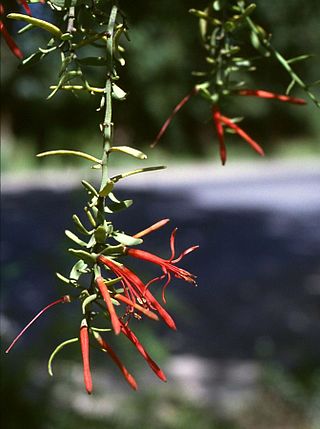
Loranthaceae, commonly known as the showy mistletoes, is a family of flowering plants. It consists of about 75 genera and 1,000 species of woody plants, many of them hemiparasites. The three terrestrial species are Nuytsia floribunda, Atkinsonia ligustrina, and Gaiadendron punctatum Loranthaceae are primarily xylem parasites, but their haustoria may sometimes tap the phloem, while Tristerix aphyllus is almost holoparasitic. For a more complete description of the Australian Loranthaceae, see Flora of Australia online., for the Malesian Loranthaceae see Flora of Malesia.
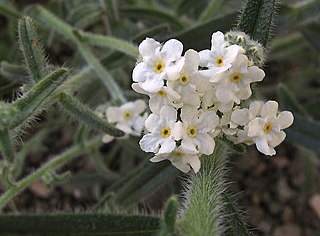
Cryptantha is a genus of flowering plants in the borage family, Boraginaceae. They are known commonly as cat's eyes and popcorn flowers. They are distributed throughout western North America and western South America, but they are absent from the regions in between.
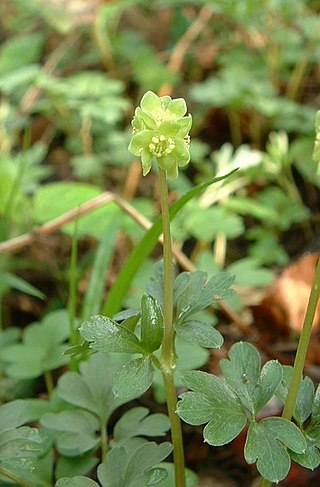
Adoxa moschatellina, moschatel, is a species of flowering plant in the family Adoxaceae which has a highly distinctive inflorescence. This herbaceous perennial grows in relatively sunny places in old woodland, such as the edges of streams, and in shady places in open habitats such as rock crevices in limestone pavements. It has a limited ability to spread by seed, but expands vegetatively via its long stolons. It is a widespread but generally uncommon plant which is not considered to be threatened within its natural range.
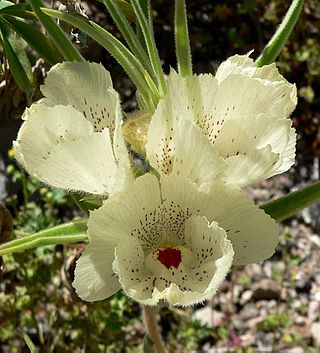
Mohavea confertiflora, the ghost flower, is a plant of the family Plantaginaceae. It is a native of the Southwestern United States, southern California, and three states of northwest Mexico.

Aucuba is a genus of three to ten species of flowering plants, now placed in the family Garryaceae, although formerly classified in the Aucubaceae or Cornaceae.
The Australian Plant Name Index (APNI) is an online database of all published names of Australian vascular plants. It covers all names, whether current names, synonyms or invalid names. It includes bibliographic and typification details, information from the Australian Plant Census including distribution by state, links to other resources such as specimen collection maps and plant photographs, and the facility for notes and comments on other aspects.

Dipterocarpus condorensis is a species of plant in the evergreen or semi-evergreen family Dipterocarpaceae.

Arctostaphylos confertiflora is a rare species of manzanita known by the common name Santa Rosa Island manzanita. This shrub is endemic to California, where it grows on the sandstone bluffs of Santa Rosa Island in the Channel Islands. This manzanita is listed as an endangered species by the United States Government.

Ambrosia confertiflora is a North American species of ragweed known by the common name weakleaf bur ragweed.
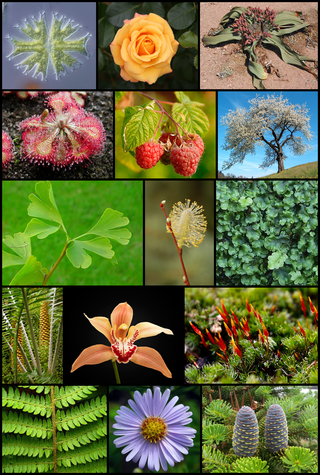
Plants are predominantly photosynthetic eukaryotes, forming the kingdom Plantae. Most of them are multicellular. Historically, the plant kingdom encompassed all living things that were not animals, and included algae and fungi. All current definitions exclude the fungi and some of the algae. By one definition, plants form the clade Viridiplantae which consists of the green algae and the Embryophyta or land plants. The latter include hornworts, liverworts, mosses, lycophytes, ferns, conifers and other gymnosperms, and flowering plants. A definition based on genomes includes the Viridiplantae, along with the red algae and the glaucophytes, in the clade Archaeplastida.

Ambrosina is a genus in the family Araceae that consists of only one species, Ambrosina bassii, and the only genus in the tribe Ambrosineae. This species is the smallest aroid in the Mediterranean, growing only to 8 cm tall. It is usually found growing in woodlands on north faces of hillsides and in humus soil that is covering limestone. It is distributed in Sardinia, Corsica, Sicily, southern mainland Italy, Tunisia, and Algeria.

Oncotheca is a genus of tree endemic to New Caledonia. There are two species, Oncotheca balansae and Oncotheca humboldtiana.

Salvia confertiflora, the Sabra spike sage, is a species of flowering plant in the family Lamiaceae, native to Brazil. This herbaceous perennial reaches 1–1.5 m (3.3–4.9 ft) in height, and 10–50 cm (3.9–19.7 in) spread in one season, becoming shrubby at the base with age.

Persoonia confertiflora, commonly known as cluster-flower geebung, is a species of flowering plant in the family Proteaceae and is endemic to south-eastern Australia. It is an erect to low-lying shrub with hairy young branches, egg-shaped to narrow elliptic leaves, and hairy yellow flowers borne on leaf axils or on the ends of short branches.

Lithospermum purpurocaeruleum is a synonym for Aegonychon purpurocaeruleum (L.) Holub, the purple gromwell, is a herbaceous perennial rhizomatous flowering plant in the family Boraginaceae.
Diospyros confertiflora is a tree in the family Ebenaceae. It grows up to 20 metres (70 ft) tall. The twigs dry to black. Inflorescences bear up to 12 flowers. The fruits are ovoid, up to 2.2 cm (1 in) in diameter. The specific epithet confertiflora is from the Latin meaning "crowded flowers". Habitat is lowland forests. D. confertiflora is found in Peninsular Thailand, Sumatra, Peninsular Malaysia and Borneo.

Corymbia confertiflora, commonly known as broad-leaved carbeen or rough leaf cabbage gum, is a species of tree that is endemic to northern Australia. It has rough, tessellated bark near the base of the trunk, smooth white to pale grey bark above, a crown of both intermediate and adult leaves, large numbers of flower buds borne on leafless sections of branchlets in groups of seven, creamy white flowers and cylindrical to barrel-shaped or bell-shaped fruit.
Excoecaria confertiflora is a species of flowering plant in the family Euphorbiaceae. It was described in 1978. It is native to Fiji.
Tetraphyllum is a genus of flowering plants belonging to the family Gesneriaceae. As of April 2021, there was no consensus as to whether the correct scientific name for the genus is Tetraphyllum or Tetraphylloides, some sources using the former and some the latter.
Paypayrola is a genus of flowering plants belonging to the family Violaceae.














